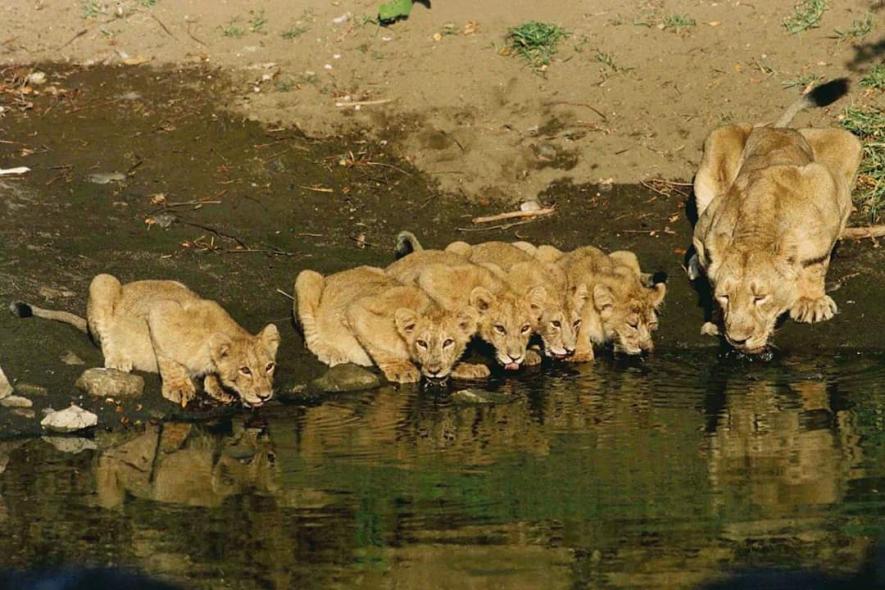After CDV Deaths, Why no Translocation of Asiatic Lions?

Photo By Bhushan Pandya
The mortality of some 92 Asiatic lions in the Gir forest region has eclipsed the positive news Prime Minister Narendra Modi shared with the world about the increase in their population on Wednesday.
“Population of the majestic Asiatic Lion, living in Gujarat’s Gir Forest, is up by almost 29%. Geographically, distribution area is up by 36%,” he tweeted.
According to Gir wildlife authorities , the population of Asiatic lions has increased from 523 in 2015 to 674 in 2020. Similarly, the distribution area of lions in the Saurashtra region of Gujarat, where Gir is situated, has also increased from 22,000 sq km to 30,000 sq km.
However, a news report has raised questions on the veracity of this population result, calling the Block Count Method or Direct Beat Verification a 100-year old archaic methodology which lacks the scrutiny of contemporary science.
Bhushan Pandya, member of the state wildlife board and renowned wildlife photographer, said that the lion population estimation was conducted in 24 hours starting at 2 pm on June 5, through lion sightings near water sources or spotting the lion pride through radio collar signals in each forest beat of about 200-250 sq km.
He said that a monthly exercise, also known as Poonam (full moon) Avlokan (Count) is conducted during the day and at night, in the light of the full moon.
The five-yearly count is done using the same method, but it stretches over two days with the involvement of around 2,000 members, comprising the forest team, people from NGOs, scientists and other experts. This year, many people other than the forest staff could not join, due to the COVID-19 pandemic, he said.
As per another report, 92 Asiatic lions have died in Gujarat’s Asiatic Lion Landscape (ALL) since January 2020, according to a Union Ministry of Environment, Forest and Climate Change (MoEF&CC) committee report. ALL includes Gir National Park and Sanctuary and covers eight districts of Gujarat, including Junagadh, Amreli, Bhavnagar, Porbandar, Rajkot, Gir-Somnath, Botad and Jamnagar, according to the 14th Lion Population Estimation Report 2015.“Some lions have died of in-fighting and many have died of the canine distemper virus (CDV). At the Jasadhar rescue centre, the two lions shown to the committee were suffering from CDV.
This time, 92 have died in five months, while 60 have died in just April and May. The Gujarat government in March 2018 had said that 184 lions have died in two years.
DT Vasavda, chief conservator of forest, Gir Forest, told NewsClick that lions have died since January for various reasons such as snake bite, drowning, natural death, infighting and disease Babesiosis. He denied any death due to CDV this year.
According to a report, CDV killed at least 36 lions in Gir in 2018 and it has not ebbed till now. That 60% of the lions are outside the protected area and increasing is another serious issue.
Shyamal Tikadar, chief wildlife warden, told NewsClick, “We are walking on the edge of the sword. Major carnivores and humans can not technically live together. We, as human beings and society, are living with animals due to our compassion, education and awareness. We have managed to avoid interfacing with the animals. But as the population of Asiatic lions is growing in Gir, I don’t know how long this coexistence will last.”
According to the WII report, 190 lion attacks on humans have been recorded between 2007 and 2016 in the Gir landscape, of which a small proportion (1.3 attacks/year) resulted in human fatalities. While attacks by leopards on humans in the same landscape were 383 between 2011 and 2016, 41 were lethal (7/year).
Nishith Dharaiya, associate professor at HNG University, who did his doctoral research on Asiatic lions and is also a member of state wildlife board, said, “The isolated satellite sites frequented by lions at Bhavnagar, Junagarh, Amreli, Girnar, Pania and Mitiyala have been expanded through corridors and extension of the forest as Greater Gir.”
Also read: How Changed Consumption Habits Can Protect Planetary Boundaries
YV Jhala, senior scientist with Wildlife Institute of India, said, “In the entire world, Gir is the only 250 sq km of secure area for Asiatic lions. There is 1,200 sq km of Gir Wildlife Sanctuary in the vicinity, which has excellent habitat for lions. The Gujarat government should create a 1,000 sq km national park by rehabilitating the villagers outside the sanctuary. This will create a vast habitat for the expanding lion population to thrive.”
However, in order to protect the lions from getting infected from a potential disease outbreak, he advocates reintroducing some of them to the Kuno National Park in Madhya Pradesh.
The Madhya Pradesh government has made “humongous efforts” for reintroduction of Asiatic lions in Kuno National park. H S Negi, additional principal chief conservator of forest, Madhya Pradesh,told NewsClick, “Madhya Pradesh government rehabilitated 1,545 families from 24 villages and expanded the existing area from 345 sq km to 748 sq km, thus up scaling the legal status of Kuno Wildlife Sanctuary to a national park.”
He added that the big buffer is connected to Madhav National Park in MP on one side and Ranthambore National Park of Rajasthan on the other side with contiguous forest cover. The rising population of lions can easily be accommodated in this huge landscape in the future.
“The present population of Asiatic lions has grown a lot from the original stock of about 20 animals. In case of a disease outbreak, the entire population can collapse. Hence, we need to trans locate at least a couple of lion prides to a geographically isolated place,” he said.
Vasavda, however, said that the Gujarat government and wildlife department are not in favour of translocation of Asiatic lions outside the state. He argued that there are many indigenous species which are confined to one particular region and they have survived well.
Faiyaz A. Khudsar, noted wildlife biologist, who has also filed a PIL in the apex court to trans locate lions to MP, told News Click, “Our country is home to the whole population of Asiatic lions. Therefore, it belongs to the entire world. We shoulder the bigger responsibility of its protection.”
He also referred to the outbreak of the CDV that had reportedly killed 1,000 of the 3,000 lions in Tanzania's Serengeti National Park in 1994.
Craig Packer, director of the Lion Research Centre at the University of Minnesota in the US and part of a team involved in mitigating the CDV outbreak at the Serengeti sanctuary, inferred that the inbred lion population is more susceptible to infectious diseases. “In a population with reduced genetic diversity, the parasite is more likely to find new victims with the same genetic susceptibility.”
Ravi Chellam, chief executive officer at Meta string Foundation and an Asiatic lion expert, said, “The Supreme Court on April 15, 2013, had ordered to trans locate Asiatic lions to Kuno within six months of its order. When that did not happen, a contempt petition was filed. I feel extremely saddened to say that nothing has happened and the matter is being delayed for one reason or the other, while CDV has already claimed so many lions in Gir.”
Also read: Centre’s Guidelines to Ease Mining Operations Might End up in Green Violations
Get the latest reports & analysis with people's perspective on Protests, movements & deep analytical videos, discussions of the current affairs in your Telegram app. Subscribe to NewsClick's Telegram channel & get Real-Time updates on stories, as they get published on our website.
























